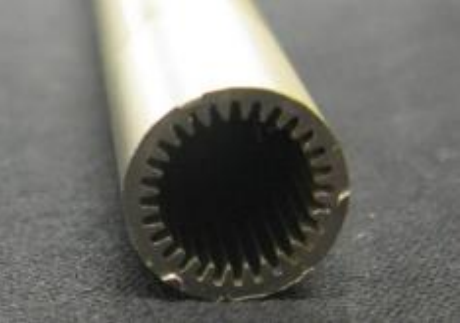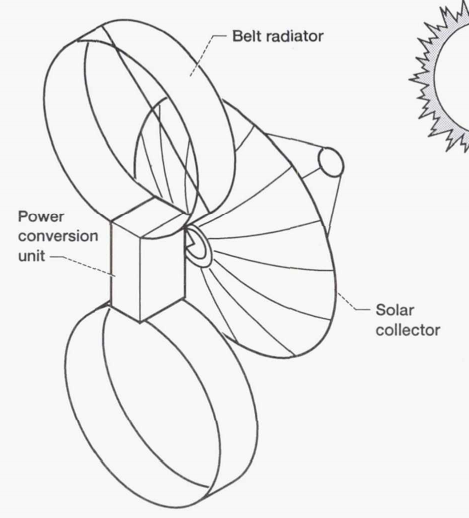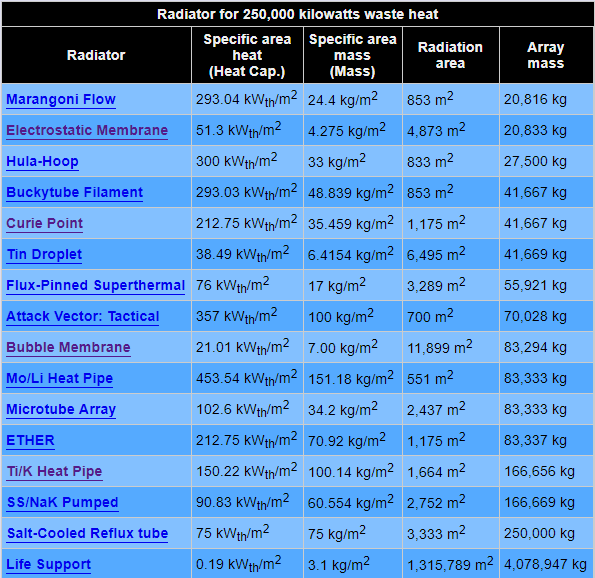As we all know, fission generates a lot of heat very efficiently, that’s the whole reason that it’s so attractive. Unfortunately, that heat all has to go somewhere, or two things will happen: the power conversion system stops working because the hot and cold ends approach the same temperature; and, your spacecraft gets baked until it’s destroyed. Heat always transfers from a higher temperature to a lower one, and how much heat is transferred depends on the temperature difference, the surface area of the thermal difference, and the thermal conduction of the materials involved. There are three mechanisms for heat to transfer: conduction (through physical contact with another material), convection (through gas heating up and then rising away from the heat source), and radiation (the infrared photons that actually make up the heat leave the substance in straight lines). Sadly, in the vacuum of space only radiation works, unless you’re throwing large amounts of gas overboard (as in an NTR, which operates on convection and radiation), which weighs a fair bit and takes up a lot of volume – and the container weighs a fair bit, too. This means that if we want to generate electricity, we have to get rid of heat through radiators, which heat a working fluid or other substance, and then use convection or conduction to an area with a large surface area to maximize the amount of surface area available for radiation. Radiators emit heat as a function of the temperature of the liquid (or gas) inside them, the surface area of the radiating surface, and several other factors, known as the Stefan-Boltzmann law (more on that in the heat rejection blog post coming up in a few posts). On the practical side of a radiator, if the substance used as a working fluid freezes at ambient temperatures, the designer needs to make sure it’s not going to freeze anywhere in the radiator and gum up the works.
 On the international space station, a pumped loop radiator using ammonia is used (and is responsible for a lot of the maintenance work done during EVAs, as was its predecessor on Mir). Higher temperature radiators can use sodium, lead-bismuth, or other liquids. The advantage to this system is that, to a degree, the more heat that needs to be rejected, the faster the pump can be run.
On the international space station, a pumped loop radiator using ammonia is used (and is responsible for a lot of the maintenance work done during EVAs, as was its predecessor on Mir). Higher temperature radiators can use sodium, lead-bismuth, or other liquids. The advantage to this system is that, to a degree, the more heat that needs to be rejected, the faster the pump can be run.

The most popular type of radiator for modern spacecraft is the titanium-water heat pipe radiator. This system doesn’t require a pump, since it works through wicking, as all heat pipes do; which means one less set of moving parts is needed. Other heat pipes are possible, at higher temperatures, including the sodium heat pipes used in Kilopower; but in order to use these, and not lose power conversion efficiency, the reactor has to operate at a higher temperature. The advantage of these heat pipes is that, due to the Stefan-Boltzmann law, these radiators can get rid of much more heat with much less mass.

More advanced options don’t use pipes to contain the liquid, but flexible membranes. The simplest uses a simple spray of liquid, which is sprayed in a controlled fashion into space toward a collector, which them pumps the liquid back into the reactor. This has a much higher surface area than a pipe-based heat radiator, since the droplets themselves have a huge surface area to volume ratio compared to the pipe surface area that’s facing space. A waterfall on the Moon may be a good method of rejecting heat, both due to the low gravity and the low average temperature (in the shade, at least).
The Russian TEM spacecraft is going to utilize a droplet radiator, which was recently tested. However, details on this system are very scant. I hope to be able to offer more details in the coming months.

Of course, if the spacecraft maneuvers before all the spray is collected, a certain amount will be lost; so it can’t effectively be used during maneuvering… unless the drops are magnetic. This is the idea behind the Curie point liquid droplet radiator, which sprays liquid metal droplets that are then collected by electromagnets. The liquid itself will be sprayed at above the Curie point of the liquid, which means that it will become magnetic after it cools past its Curie point. This system is likely to be a heavy power hog, though, and the returning working mass is probably a solid, which has its own (not insurmountable) issues with return to the core to be recycled. One advantage to this is that the phase change from solid to liquid absorbs a fair bit of energy, and vice versa releases a fair bit, so it is more efficient at power transfer in that way.

Another option, which would require less mass, is the membrane radiator, where the droplets are sprayed onto a membrane, which then collects them through centrifugal force. This has been proposed in a number of configurations, including spherical shapes, belts, and others. The most studied version was proposed by Boeing for a nuclear electric manned spacecraft, this reactor used liquid sodium that transferred the heat through a heat exchanger into water, and then had a distorted spherical membrane to catch the droplets. This system was called the Rotating Multi-Megawatt Boiling Liquid Reactor, and will be one of the systems we cover in the future.
However, these aren’t the only options for radiators. Anything that can efficiently conduct heat, and that has a high surface area, can be used as a radiator. Assuming carbon nanotubes are able to be made miles long, a collection of these would make a good radiator, due to their high thermal conductivity and large surface area. This is the principle behind “belt”, “wire”, or “spaghetti” radiator designs.
Ideas abound on how to maximize radiation abound, and we’ll cover them more in depth in a later post. I leave this topic with a chart comparing many different options for heat rejection systems, from Winchell Chung’s wonderful Atomic Rockets website, showing heat capacity, specific area mass, radiation area, and array mass (including supporting structures) for various proposed and historical systems, most of which we’ll cover at some later point.

